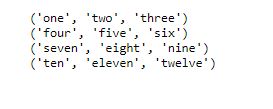
Splitting a List into equal Chunks in Python
There are cases where you want to split a list into smaller chunks or you want to create a matrix in python using data from a list. In this article we have specified multiple ways to Split a List, you can use any code example that suits your requirements.
1. Using list comprehension
This way is recommended when working on simpler tasks.You can use methods and encapsulate these tasks inside the methods.
Example:
#splitting list into even chunks using list comprehension my_list = ['one', 'two', 'three', 'four', 'five', 'six', 'seven', 'eight', 'nine', 'ten', 'eleven', 'twelve'] n = 3 [my_list[i:i + n] for i in range(0, len(my_list), n)]
Output:

2. Using user-defined method
To yields successive n-sized chunks where n refers to the number at which a split need to be made we can define a method that iterates over the list.
Example:
#splitting list into even chunks using user defined method my_list = ['one', 'two', 'three', 'four', 'five', 'six', 'seven', 'eight', 'nine', 'ten', 'eleven', 'twelve'] # defining the function def split_into_chunks(l, n): for i in range(0, len(l), n): yield l[i:i + n] # produces successive n-sized chunks of list print(list(split_into_chunks(my_list, 3)))
Output:
![]()
3. Using itertools
The itertools method provides a generator that requirements to be iterated over with the help of a for loop.
Example:
#splitting list into even chunks using itertools my_list = ['one', 'two', 'three', 'four', 'five', 'six', 'seven', 'eight', 'nine', 'ten', 'eleven'] from itertools import zip_longest def group_elements(n, iterable, padvalue=None): return zip_longest(*[iter(iterable)]*n, fillvalue=padvalue) for i in group_elements(3,my_list): print(i)
Output:

As you can see in the above result there are eleven items and hence to slice the list evenly it has taken none in the last row
4. Using lambda and islice
A lambda and slice method together give a generator that needs to be iterated over. The islice method is utilised to print precise values present in an iterable container.
Example:
#splitting list into even chunks using lambda and islice my_list = ['one', 'two', 'three', 'four', 'five', 'six', 'seven', 'eight', 'nine', 'ten', 'eleven', 'twelve'] from itertools import islice def group_elements(it, size): it = iter(it) return iter(lambda: tuple(islice(it, size)), ()) for i in group_elements( my_list , 3): print(i)
Output:

5. Using a lambda function
We can also use a simple lambda function chunk the data into a particular size.
Example:
#splitting list into even chunks using lambda my_list = ['one', 'two', 'three', 'four', 'five', 'six', 'seven', 'eight', 'nine', 'ten', 'eleven', 'twelve'] n = 4 chunk_data = lambda my_list, n: [my_list[x: x+n] for x in range(0, len(my_list), n)] chunk_data(my_list, n)
Output:

In the above example if you can observe depending on the value of n slicing takes place.
In this article we have discussed a variety of ways in which a matrix like structure can be created without help of Numpy.



